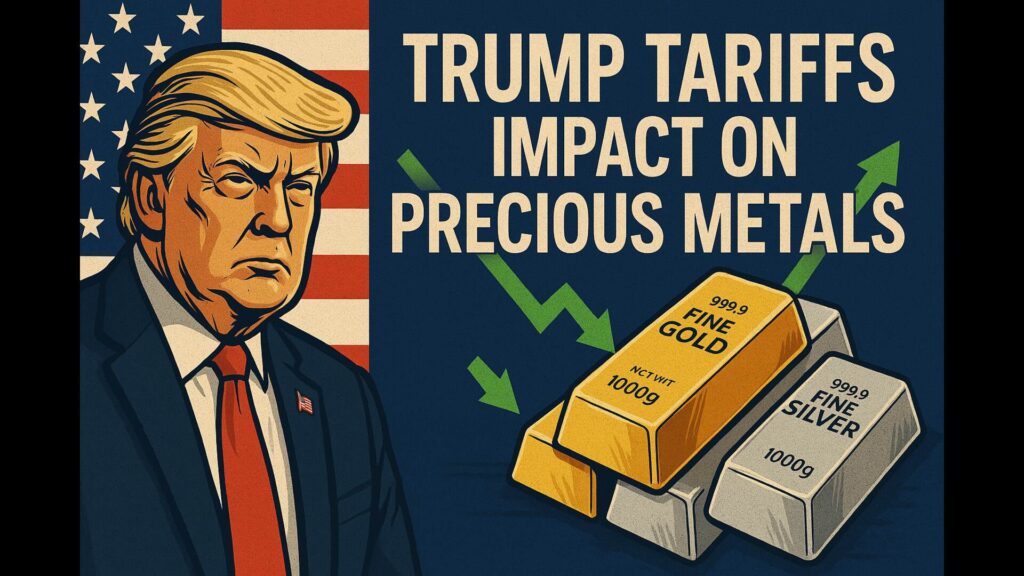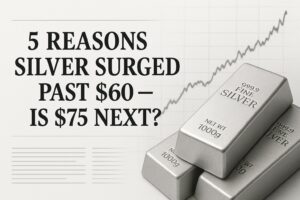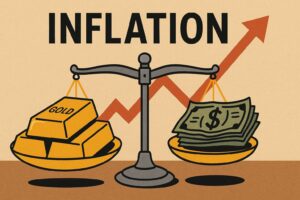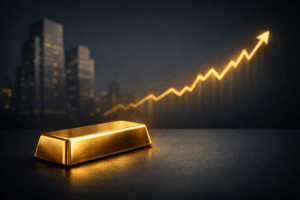The recent Trump tariffs impact on precious metals is becoming increasingly evident as many investors seek safe haven assets amid the market volatility. We’ll examine how these trade policies are reshaping precious metals investments and what strategic adjustments you should consider for your portfolio.
President Trump’s tariffs on imports from dozens of countries came into force Wednesday, April 9th, 2025 and included 104% on goods from China. China has responded in kind with 84% retaliatory tariffs.
Later on April 9th, President Trump has announced a 90-day pause on higher reciprocal tariffs that hit dozens of trade partners, while raising duties on China to 125%. The situation is evolving and changing very quickly.
On April 10th, the White House reported increasing tariffs on China to 145%. The next day, China increased its tariffs on U.S. imports to 125% in response.
On April 16th, the White house announced through a press release that China now faces up to a 245% tariff on imports to the United States as a result of its retaliatory actions.
Update: On April 23rd, President Trump is now backtracking from his previous hardline position by announcing that tariffs on Chinese goods will be significantly reduced from the current 145% level if negotiations with China progress.
Notably, gold and silver imports remain exempt from these tariffs, reflecting their unique status as monetary metals critical to financial markets and central bank reserves. This exemption may help stabilize precious metals supply chains despite broader trade disruptions.
Understanding the Current Tariff Landscape
The Trump administration has announced substantial tariffs on imported goods, targeting major trading partners. These measures, designed to protect domestic industries and reduce trade deficits, have broad implications for global markets and investor sentiment.
As outlined in our recent analysis on Trump’s tariff chaos, these developments have sent investors scrambling for safe-haven assets as uncertainty mounts. According to Reuters, gold prices have hit record peaks following these announcements, reinforcing the metal’s role during periods of economic uncertainty.
How Tariffs Influence Precious Metals Markets
Gold’s Response to Economic Uncertainty
Gold has historically served as a safe-haven asset during periods of economic and geopolitical uncertainty. The implementation of tariffs typically creates several conditions that favor gold price appreciation:
- Increased Economic Uncertainty: Tariffs disrupt established trade patterns and supply chains, introducing unpredictability into market forecasts.
- Inflation Concerns: Tariffs can increase the cost of imported goods, potentially contributing to inflationary pressures.
- Currency Volatility: Trade tensions frequently lead to currency fluctuations, with investors seeking stability in gold.
Our analysis of gold market volatility shows that these factors have contributed to gold’s impressive performance during previous periods of trade tensions, with some estimates pointing to as much as 40% annual gains during peak trade war concerns.
Silver’s Dual Nature Under Tariff Conditions
Silver presents a more complex investment case due to its dual role as both an investment asset and an industrial metal:
- Safe-Haven Appeal: Silver benefits from its status as a precious metal during uncertain times, though typically to a lesser extent than gold.
- Industrial Demand Concerns: Silver’s extensive use in manufacturing means tariffs affecting these industries can impact demand.
As Bloomberg reports, broader commodities markets, including industrial metals, face potential demand challenges as tariffs threaten economic growth —a factor that adds complexity to silver’s price dynamics compared to gold.
Historical Perspective and Strategic Indicators
Looking at previous periods of trade tensions provides valuable context. During the 2018-2019 U.S.-China trade tensions, gold prices rose approximately 18.3% in 2019, while silver gained 15.2%.
The gold-to-silver ratio bears special attention during tariff implementation. Historically, this ratio has fluctuated between 70:1 and 85:1 over the past decade, but significant economic policy shifts can drive it toward either extreme:
- When the ratio exceeds historical averages, silver may be undervalued compared to gold
- Extreme ratio levels often return to normal over time
- Strategic investors frequently use these extreme ratios as signals to adjust their portfolios
The Inflation Factor
One significant channel through which tariffs affect precious metals is the inflation outlook. Investment News reports that tariffs typically increase imported goods prices, potentially contributing to broader inflation throughout the economy.
Tariffs essentially function as taxes on imported goods, raising costs for businesses that are often passed on to consumers. Gold and silver have historically served as inflation hedges, though with different effectiveness:
- Gold has consistently maintained purchasing power over long inflationary periods. During the high inflation of the 1970s, gold prices increased over 700%.
- Silver’s inflation-hedging properties are generally strong but more variable, with its industrial applications sometimes causing price movements independent of inflation.
Our analysis on the true impact of precious metals during economic uncertainty reveals that central bank gold stockpiling often serves as a leading indicator of inflationary concerns, even before official data confirms the trend.
Practical Steps for Investors
Immediate Portfolio Review
- Assess current precious metals allocation against recommended ranges
- Evaluate whether physical ownership, ETFs, or mining stocks best serve your objectives
- Consider the balance between gold and silver based on your outlook
Implementation Considerations
- For those increasing allocations, consider dollar-cost averaging rather than lump-sum purchases
- Pay attention to premiums over spot prices, which often expand during high demand
- Evaluate storage options if increasing physical holdings
As reported by Reuters, the surge in gold prices following tariff announcements has been accompanied by increased physical buying activity, potentially affecting premiums and availability of certain products.
Balancing Your Portfolio During Tariff Uncertainty
The Trump tariffs impact on precious metals extends beyond immediate price movements to influence long-term investment strategies. As new tariff policies disrupt established trade patterns and potentially trigger inflationary pressures, investors are reconsidering their asset allocations. Historical data suggests that during similar periods of economic policy shifts, gold has typically outperformed as a safe-haven asset while silver’s dual role as both industrial metal and investment vehicle creates a more complex response pattern. Analysts watching the Trump tariffs impact on precious metals note that the gold-to-silver ratio often serves as a key indicator of market sentiment and could signal tactical opportunities for portfolio adjustments.
The implementation of tariffs creates a complex economic environment with meaningful implications for precious metals investments. While historical patterns suggest gold and silver often benefit during periods of trade tension, their performance can vary significantly based on specific circumstances.
Rather than making dramatic portfolio shifts, investors should consider measured adjustments within their overall investment strategy and risk tolerance. The case for maintaining some allocation to precious metals—particularly during periods of economic policy uncertainty—remains compelling.
By understanding the distinct roles of gold and silver in a portfolio and implementing a thoughtful allocation strategy, investors can navigate the current tariff environment with greater confidence.
Note: This article is provided for informational purposes only and should not be considered investment advice. Economic conditions and market reactions are complex and unpredictable. Historical performance is not indicative of future results. Always conduct thorough research or consult with a financial advisor before making investment decisions.









